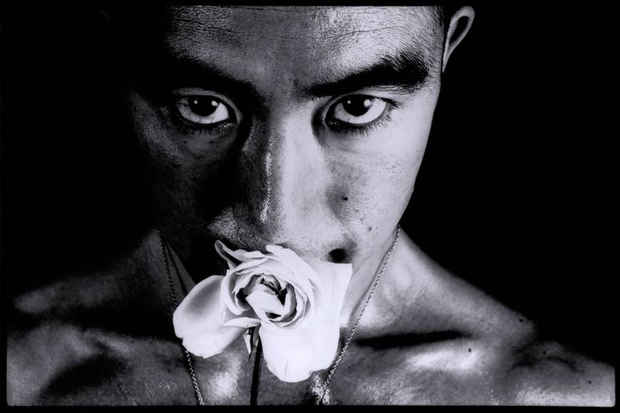Eikoh Hosoe “Ba-Ra-Kei / Ordeal By Roses”
Envoy Enterprises (87 Rivington St.)

This event has ended.
Eikoh Hosoe is a Japanese photographer and filmmaker who emerged in the experimental arts movement of post-World War II Japan.
In September 1961, controversial author Yukio Mishima asked his publisher to commission Eikoh Hosoe, to take his portrait for the cover of his book of critical essays.
What was originally intended as a simple portrait turned into a large project in which Mishima wanted no responsibility other than being the subject. He gave Hosoe, who was in his late 20s at the time, full artistic direction.
Eikoh Hosoe believes that a person’s soul lives in his possessions, particularly in art objects, which according to him, live together with an artist’s soul. Using this believe as a starting point, he chose a wide range of objects that surrounded the writer in the baroque interior of his Tokyo home. In doing so, he revealed Mishima’s dark, theatrical imagination, which is antithetical to the pure Japanese sensibility of understatement. In some pieces, Hosoe utilized Mishima’s photographs of paintings of St. Sebastian and his many black-and-white photographs of paintings by Italian Renaissance artists, such as Raphael and Botticelli, to create images that show Mishima’s body combined with his favorite Renaissance paintings. Anything Mishima possessed, and anything he had a relationship with, became part of Hosoe’s palette.
After six months and a total of ten photo sessions, which lasted until the summer of 1962, Ba-ra-kei (Bara meaning “rose” and kei meaning “punishment,” or literally translated punishment of roses) was completed. By borrowing Mishima’s flesh and using a rose as a visible symbol of beauty and thorns, Hosoe delivered a series of work consisting of a number of dark, erotic images, centered on the male body,
The exhibition and subsequent book were entitled Ba-ra-kei. It solidified Mishima’s reputation as a controversial figure of the arts and established Hosoe as one of Japan’s leading contemporary photographers. A decade later an English version of Ba-ra-kei was scheduled for publication. Hosoe intended to translate the title as Killed by Roses, but at Mishima’s insistence the title was changed to Ordeal by Roses.
In the preface to the book, Mishima wrote:
Before Hosoe’s camera, I soon realized that my own spirit and the workings of my mind had become totally redundant. It was an exhilarating experience, a state of affairs I had long dreamed of. Hosoe merely explored via the medium of his camera—much as the novelist uses words and the composer sounds—the various combinations in which the objects to be photographed could be placed, and the light and shadow which made these combinations possible. For him, in short, the objects correspond to words and sounds.
The series of surreal and alluring photographs shows Eikoh Hosoe’s amazing talent and offers a rare glimpse into the life of Yukio Mishima.
Eikoh Hosoe’s work is currently on display at the Tate Modern though 12 June, 2016.
Eikoh Hosoe was born March 19th, 1933 in Yonezawa, Yamagata, Japan.
The artist’s work is in the permanent collection of museums such as: National Museum of Art, Kyoto; Museum of Modern Art, New York; International Museum of Photography, George Eastman House, Rochester, New York; Smithsonian Institution, Washington D.C.; National Gallery of Canada, Ottawa; Victoria & Albert Museum, London; Bibliotheque Nationale, Paris; Museum of Modern Art, Paris; Centre George Pompidou, Paris; National Gallery of Australia, Canberra; Art Institute of Chicago; Hamburg Museum of Art, Tokyo Metropolitan Museum of Photography, …
In 2002 he was awarded The Royal Photographic Society’s Special 150th Anniversary Medal and Honorary Fellowship) in recognition of a sustained, significant contribution to the art of photography.
Media
Schedule
from April 17, 2016 to May 15, 2016
Opening Reception on 2016-04-17 from 18:00 to 20:00